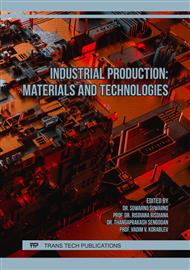[1]
G.S. Cole and A.M. Sherman, Light weight materials for automotive applications, Materials Characterization, 35(1) (1995) 3-9.
Google Scholar
[2]
H.Ye, Review of the development of Al-Si-Alloy based material for engine applications. J. of Material Eng. and Perform.12 (2003) 288–297.
Google Scholar
[3]
J.Hirsch, Aluminium alloys for automotive application, In Materials Science Forum, Trans. Tech. Publications Ltd. 242 (1997) 33-50.
DOI: 10.4028/www.scientific.net/msf.242.33
Google Scholar
[4]
Z. Huda, N. I. Taib, T. Zaharinie, and Characterization of 2024-T3: An aerospace aluminum alloy, Materials Chemistry and Physics. 113 (2009) 515-517.
DOI: 10.1016/j.matchemphys.2008.09.050
Google Scholar
[5]
S.Bozorgi and K.Anders.Mechanical Properties of high copper containing al-cu-si cast alloys at elevated temperature, Proceedings of ICAA-16 (2018).
Google Scholar
[6]
K.A. Olaiya, M.O. Adeoti, I.A. Adigun, R.O. Saheed, U. Eboreime and L.O. Jimoh, Comparative study of the mechanical properties of sandcast and die-cast aluminium for engineering applications. International Journal of Scientific & Engineering Research. 10(8), (2019).
Google Scholar
[7]
A.M. Nabawy, A.M. Samuel, H.W. Doty, A review on the criteria of hot tearing susceptibility of aluminum cast alloys. Inter Metal cast. 15 (2021) 1362–1374.
DOI: 10.1007/s40962-020-00559-3
Google Scholar
[8]
D. Minglong, F.Wang, X. Du, W. Wang, P. Mao, Z. Wang, L. Zhou, and Z. Liu, Effects of alternating magnetic field on the hot tearing susceptibility and microstructure of Al-5Cu alloy, International Journal of Metal casting. (2022) 1-13.
DOI: 10.1007/s40962-022-00781-1
Google Scholar
[9]
G. Razaz and T. Carlberg, Hot tearing susceptibility of aa3000 aluminum alloy containing Cu, Ti, and Zr, Metallurgical and Materials Transactions A, 50 (2019) 3842–3854
DOI: 10.1007/s11661-019-05290-1
Google Scholar
[10]
V. Khalajzadeh, and C. Beckermann, Simulation of shrinkage porosity formation during alloy solidification, Metallurgical and Materials Transactions A. 51(5) (2020) 2239-2254.
DOI: 10.1007/s11661-020-05699-z
Google Scholar
[11]
S.Seifeddine,M.Wéssen and I.L. Svenssonm,Use of simulation to predict microstructure and mechanical properties in an as-cast aluminium cylinder head – comparison with experiments, Metallurgical Science & Technology. (2006) 24(2).
Google Scholar
[12]
Z. Yao, D. Montiel, & J. Allison,Investigating the effects of dendrite evolution on microsegregation in Al–Cu Alloys by coupling experiments, Micro-modeling, and Phase-Field Simulations. Metallurgical and Materials Transactions A, 53(9), (2022)3341-3356.
DOI: 10.1007/s11661-022-06748-5
Google Scholar
[13]
K. S. Pulisheru, & A. K. Birru, Effect of pouring temperature on hot tearing susceptibility of Al-Cu cast Alloy: Casting simulation. Materials Today: Proceedings, 47, (2021)7086-7090.
DOI: 10.1016/j.matpr.2021.06.182
Google Scholar
[14]
A. Kordijazi, D. Weiss, S. Das, & P. Rohatgi, Manufacturing A206 Aluminum Alloy by Step Sand Casting: Effect of Solidification Time on Mechanical and Surface Properties of the Cast Samples Using Experimental and Simulation Results. In Light Metals 2021 (pp.147-157).
DOI: 10.1007/978-3-030-65396-5_22
Google Scholar
[15]
M.V. Dehnavi, H. Faeenezha, M.H. Sabzevar, Investigation The solidification Of Al-4.8 Wt.% Cu alloy at different cooling rate by computer-aided cooling curve analysis, Metallurgical and Materials Engineering. (2014) 20(2)
DOI: 10.5937/metmateng1402107d
Google Scholar
[16]
S. Farahany, A. Ourdjini, M.H. Idris, and S.G. Shabestari, Computer-aided cooling curve thermal analysis of near eutectic Al–Si–Cu–Fe alloy. Journal of thermal analysis and calorimetry.114(2) (2013) 705-717.
DOI: 10.1007/s10973-013-3005-7
Google Scholar
[17]
G. Mao, D. Liu, W. Gao, S. Liu, & L. Zhong, The effects of copper (Cu) or zinc (Zn) on fluidity of A357 alloy. Materials Letters,(2021)304, p.130733.
DOI: 10.1016/j.matlet.2021.130733
Google Scholar



